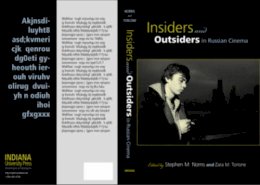
Insiders and Outsiders in Russian Cinema
Norris
Identifying who was "inside" and who was "outside" the Soviet/Russian body politic has been a matter of intense and violent urgency, especially in the high Stalinist and post-Soviet periods. It is a theme encountered prominently in film. Employing a range of interpretive methods practiced in Russian/Soviet film studies, Insiders and Outsiders in Russian Cinema highlights the varied ways that Russian and Soviet cinema constructed otherness and foreignness. While the essays explore the "us versus them" binary well known to students of Russian culture and the ways in which Russian films depicted these distinctions, the book demonstrates just how impossible maintaining this binary proved to be.
Contributors are Anthony Anemone, Julian Graffy, Peter Kenez, Joan Neuberger, Stephen M. Norris, Oleg Sulkin, Yuri Tsivian, Emma Widdis, and Josephine Woll.
Product Details
About Norris
Reviews for Insiders and Outsiders in Russian Cinema
Choice
[The editors] and the volume's contributors offer an insightful survey of how Soviet and Russian cinema constructed the meanings of Soviet, Russian and foreign identities over the course of the twentieth and early twenty-rst centuries. . . . It will be useful to graduate students and scholars working in the area of Russian andlm studies.V.89.3 Jully 2011
Slavic and East European Review
. . . Stephen Norris and Zara Torlone have . . . produced an anthology that is the best I have ever had the pleasure of reading. . . Lucidly written, well researched, persuasively argued, lavishly illustrated, Insiders and Outsiders in Russian Cinema can be read with pleasure and profit by anyone from the general reader interesed in Russian culture to the most seasoned Russian film specialist.Vol. 68.2 April 2009
Denise J. Youngblood
University of Vermont
. . .a fine collection of essays by leading film scholars . . . .Vol. 68.4 Winter 2009
Brigit Beumers
University of Bristol
In a word, the theoretical richness and sophistication of this collection parallel the complexity of its topics and serve as an excellent cross-section of how the theme of foreigners and outsiders is examined in comtemporary studies in film. Volume 54, Issue 4 Winter 2010
Slavonic & East European Journal
